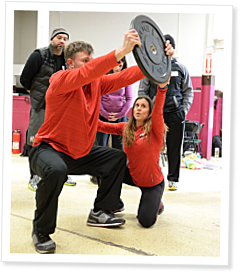
Degree or no degree, fitness trainers who lack practical experience are still students.
The state of personal training is such that criticisms are often leveled at anyone who does not have certification A, B or C or doesn't have a college or university degree.
Strangely glossed over in most dialogs of the occupation is experience-or lack of it. Experience obviously affects both personal trainers and their clients, but let's refine the context: A personal trainer who has gone only through an educational pathway without experiencing the rigors of training and the challenges of teaching fitness remains a student and is not an independent and prepared trainer. This is not a bad thing; it simply means that the trainer's education is incomplete.
Trainers who work hard to gain a vocational education and certification are most frequently criticized for being trained and certified without acquiring practical skills. But experience in personal training of clients is largely absent from all preparatory pathways for the trainer, including college and university programs.
So how does a neophyte trainer fresh out of an educational program gain relevant experience before working with customers? In an overwhelming number of instances, he or she doesn't but actually gains all experience on the job, often with no supervision.
Only one educational system in the fitness industry supplies a robust set of educational and practical requirements. The CrossFit system is a pathway of combined instruction and practical experience. To be become a Certified CrossFit Trainer (CCFT), a student must acquire 32 hours of lecture and practical study when earning CrossFit Level 1 and Level 2 certificates. This is about the same as a two-credit-hour university course. The CCFT candidate must also acquire 750 verified practical hours training clients in the CrossFit method. (An alternate path requires 1,500 hours of verified general-physical-preparedness strength-and-conditioning instruction at the collegiate level or higher.) Finally, the candidate must pass an examination. The CCFT credential, accredited by the American National Standards Institute, requires maintenance through 50 continuing-education units and 900 coaching hours (300 per year) every three years.
All this does not consider the amount of independent study in the preparatory process-probably about another 64 to 96 hours, as would be recommended for any college or university study.
Trainers with the CCFT credential can later take a performance exam and achieve the Certified CrossFit Coach credential (CCFC). Before qualifying to take the CCFT exam, a trainer will have spent 13 percent of time in class and study, with the remaining 87 percent of time spent in required practical work experience.
All other major personal-training certificates or certifications are based completely on class and study time, with no required person-to-person practical elements. It is also apparent that CrossFit is much more similar to apprenticeship programs than it is to university exercise-degree programs, in which it is typical to find 93 percent or more of the student's time spent in class or study and 7 percent (or much less) spent acquiring practical experience in the workplace.
No comments:
Post a Comment